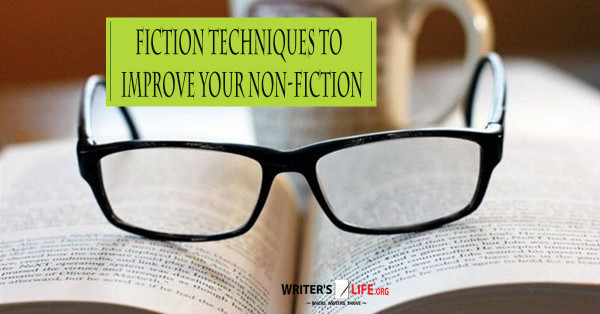- How To Tackle Jealousy In Creative Writing
- Common Submission Mistakes
- How To Stop Your Blog Becoming Boring
- The One Thing Every Successful Writer Has In Common
- How To Make Yourself Aware Of Publishing Scams
- Why Almost ALL Writers Make These Grammar Mistakes At Some Point
- 5 Tips For Authors On How To Deal With Rejection
- Top Mistakes to Avoid When Writing a Novel
- How to Avoid Common New Writer Mistakes
- 10 Mistakes New Fiction Writers Make
Fiction Techniques To Improve Your Non-Fiction

Hello, and welcome back to Writer’s Life! Today I’d like to discuss with you some fiction techniques to improve your non-fiction, ways that can turn a potentially dry topic into a can’t-miss, must-read experience for your readers. Although some non-fiction does not lend itself to engaging storytelling, some of it can be adapted to use some or all these ideas (and others). Biographies, in particular, can be a great place to use these techniques, as can blog posts or other projects about historical events, battles, and so forth. There are others, as well, so don’t discount these techniques just because you’re not writing one of those kinds of works.
Engage the reader in all five senses
Creating evocative scenes for your readers can make a non-fiction work come alive. If possible, give them the scents of the ranch where your biography’s subject grew up. Describe the tactile feel of the bridle as they learn how to dress a horse or the sensation of slipping into the pig trough while learning to feed the animals. Engage the reader in as many senses as you can, to make the story visceral. These descriptions can help readers truly connect with the story.
Use setting, dialog, and characters
You can improve the story of the non-fiction work by developing the dialog, the other characters, and using descriptive settings. As an example, let’s say you are writing a biography of Kit Carson. You might include known vignettes of dialog to set the mood, or establish relationships and motivations for the “characters” of the work. Include the backstories of other characters, at least some of them, to flesh out the story. Incorporate the readers' senses, as above, with these descriptions to make them even more memorable.
Create an emotional response
Give your reader a reason to care. Not just about the work overall (they likely already care a little bit if they are reading it) but about each thing that happens. You can grip even someone who knows what happens by how you present your subject. They may find your work more compelling because you injected some emotion into it. Highlight stories about the subject that reveal his or her deep connection to caring for animals, or even that time the subject was beaten up by a gang of ruffians intent on burning the barn down, things that will enflame the reader’s passion and support for the subject. Or, go the other way, and tell the story about how the subject didn’t care about animals, and was even caught doing something mean—pulling the barn cat’s tail, say—and had to learn how to be compassionate. Perhaps his father punished him for pulling the cat's tail and the subject resented it until he saw the cat defending her kittens or fending off a prowling wolf looking for easy prey in the barn that the subject had left open. That kind of thing can resonate, and the emotional connection between reader and subject can really make the story seem current and alive.
Create drama
From an emotional response, you can hook a reader into sticking through the story to the bitter end. If your subject supports it, use elements of drama to keep your reader turning the pages. Let’s say your subject was married and wound up marrying the girl he’s so frustrated with while cleaning out the barn or feeding the animals. Tell the story about the two of them getting into a yelling match at 10 years old about how to best approach pig slop, and how the subject fell into the trough while being pig-headed about his way of doing things. Create tension between the two, which then becomes a plot twist later when they get married and have a fantastic life together.
In Conclusion
As you can see, writing non-fiction can certainly be as creative an endeavor as fiction. Using some of the same techniques can result in gripping page-turning stories that readers not only can’t put down, but tell all of their friends to read as well. I hope that using some of these fiction techniques to improve your non-fiction have inspired you to experiment with your own work. As always, if you have comments or questions leave them below, and happy writing!


























